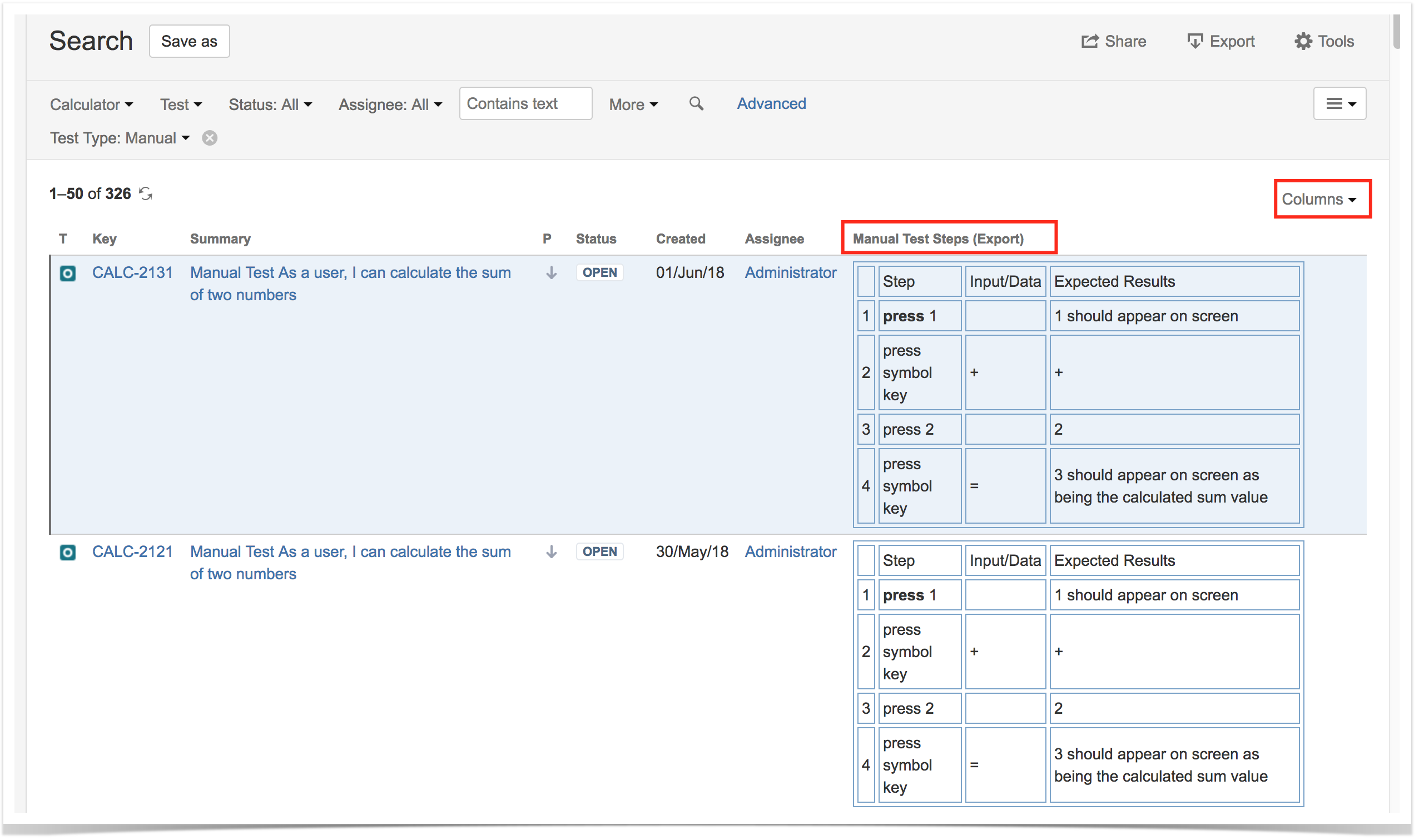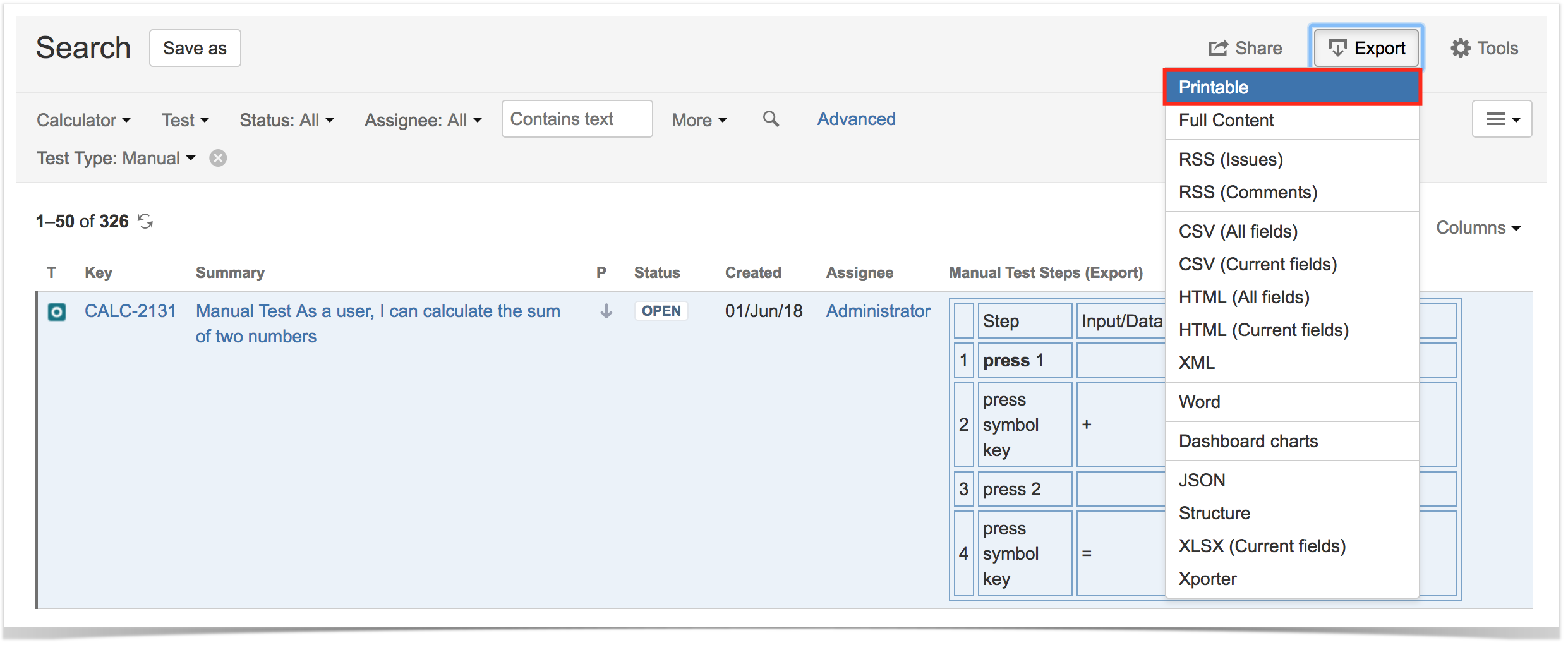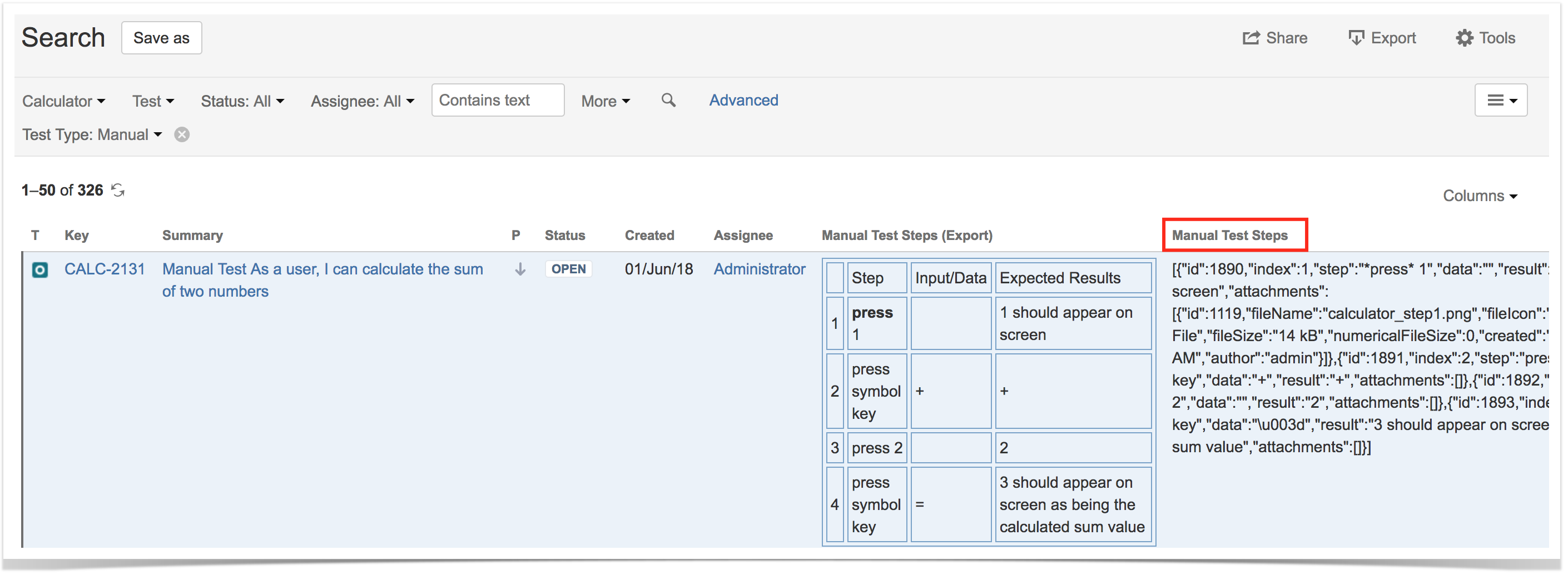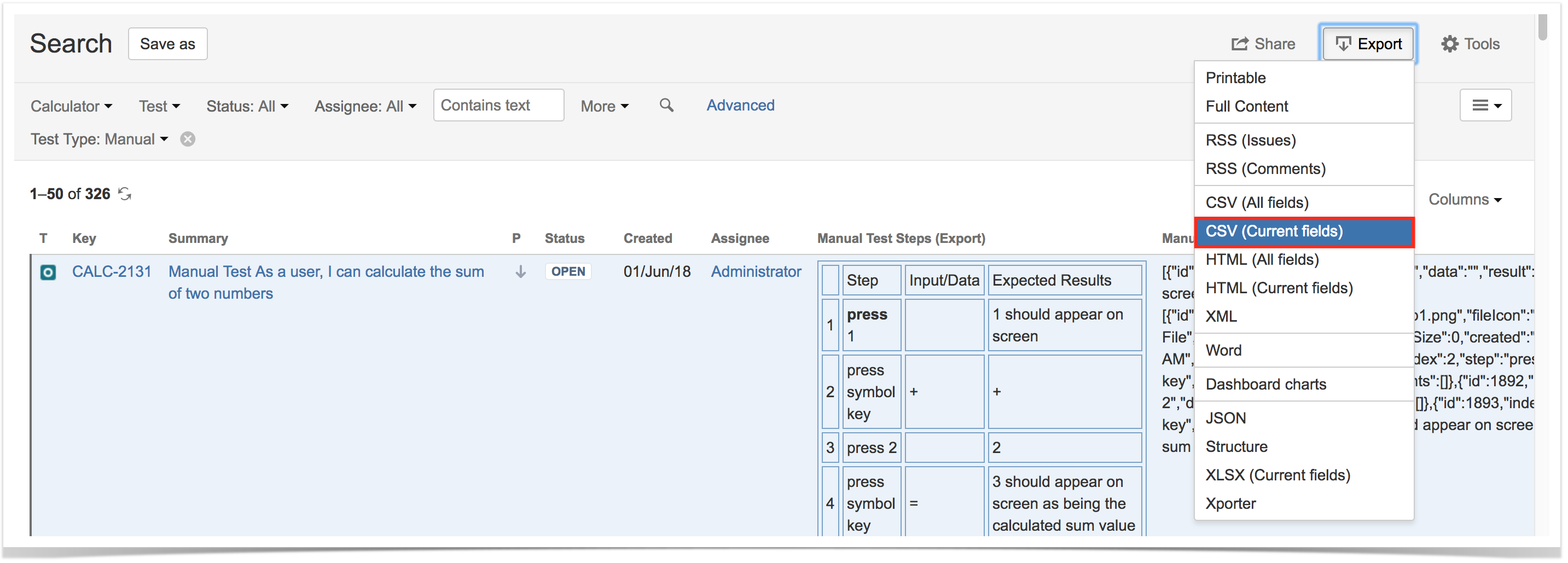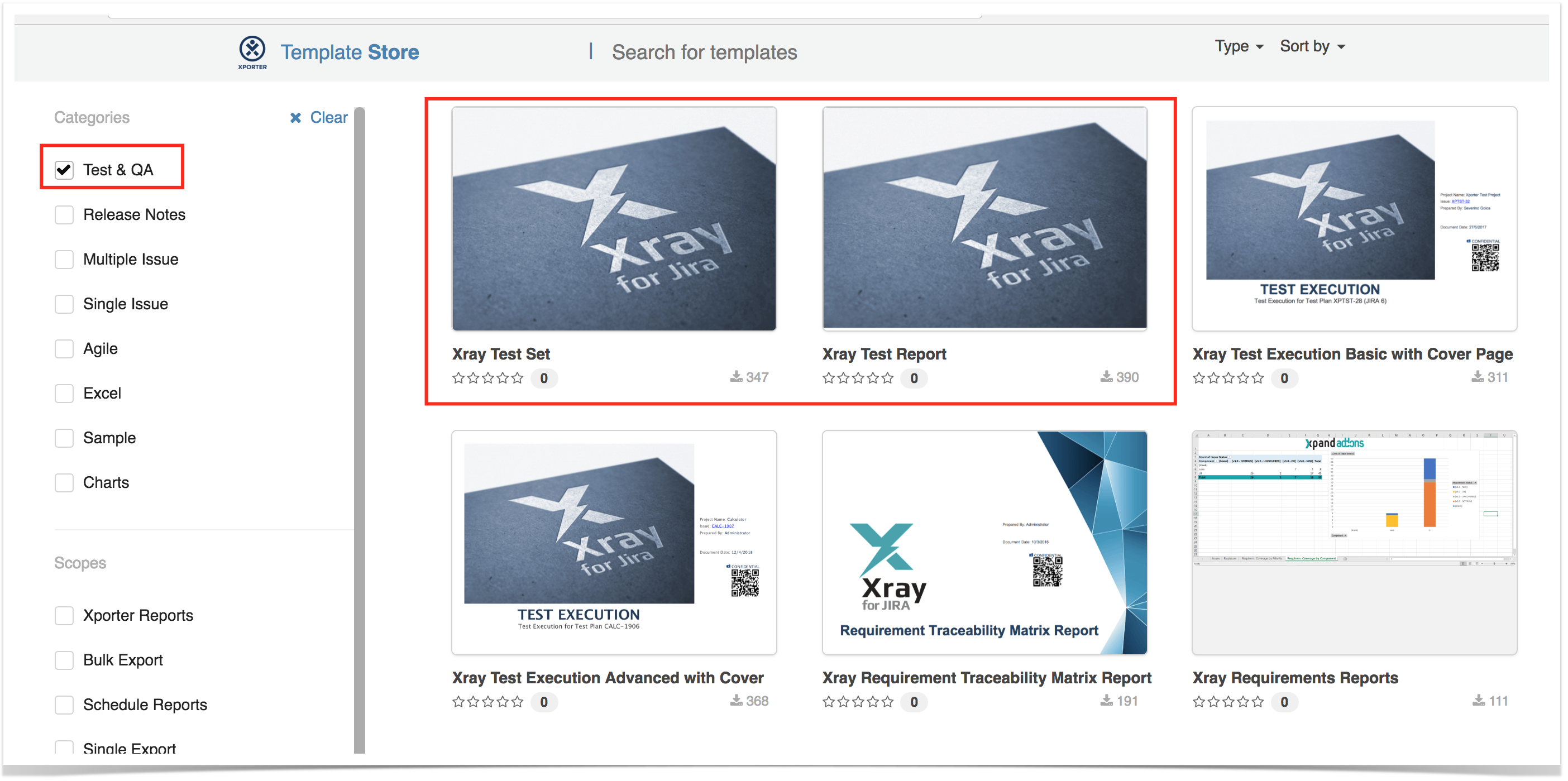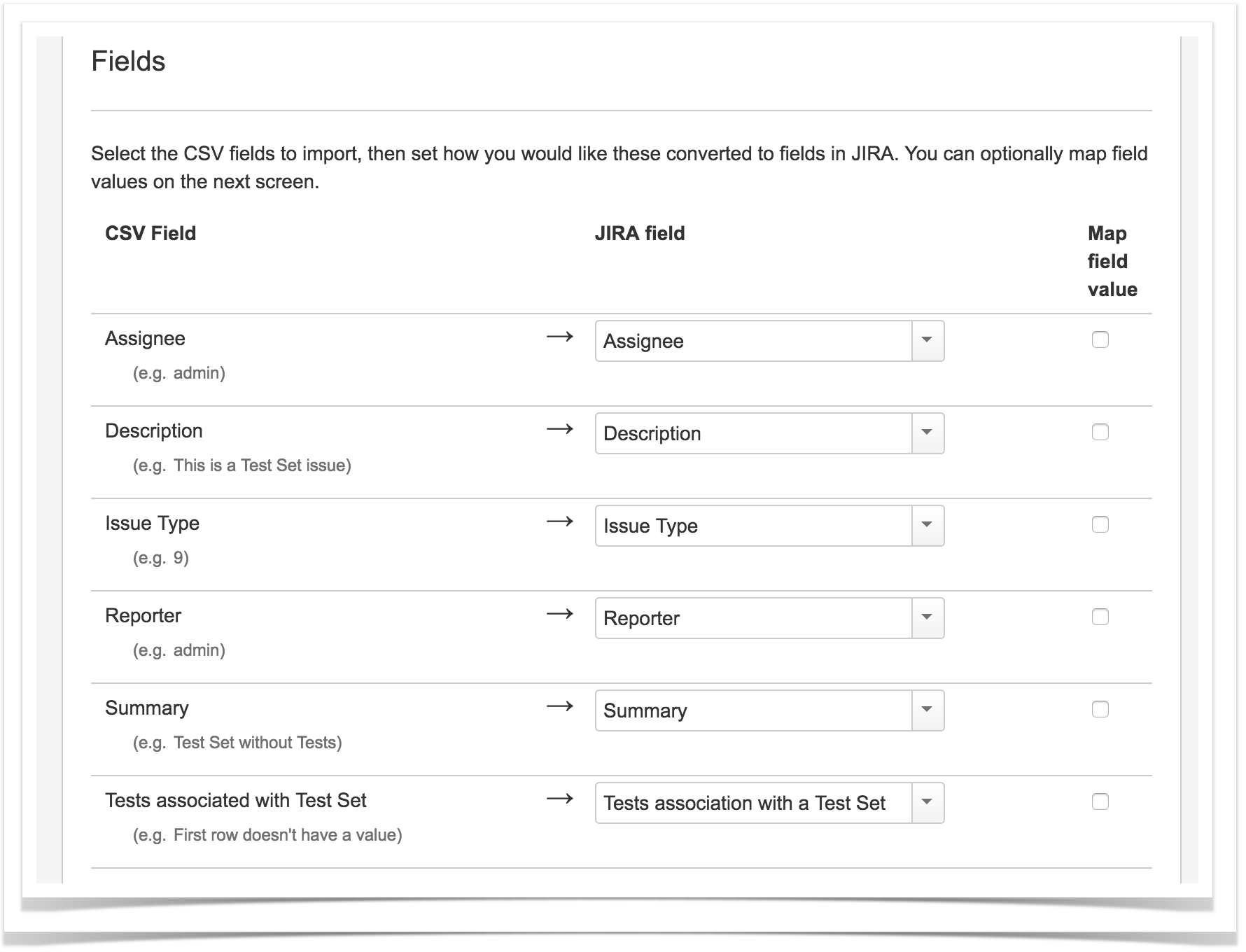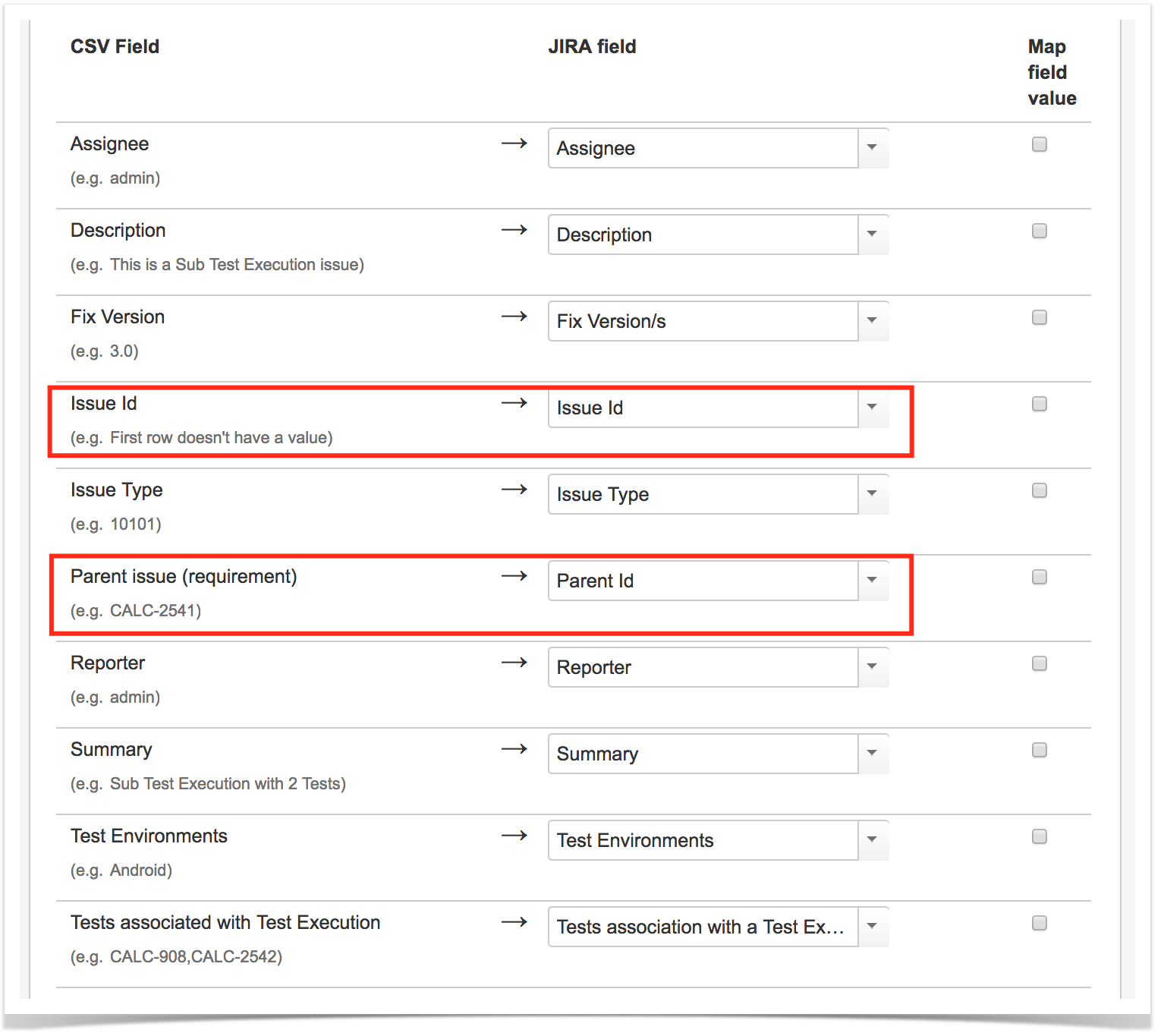Page History
...
- "Test Type" is "Automated[Generic]"
- "Generic Test Definition" is the test definition.
Export Tests
Jira lets you export your data in CSV or Excel (file is saved as XLS, but you can open it with your spreadsheet tool and export it to CSV). Xray custom fields are compatible with this function. Even Manual Test Steps field can be exported in a JSON format so that it can be imported back to Jira directly.
| Info | ||
|---|---|---|
| ||
Since Jira 7.2, Jira only provided the ability to export issues to CSV in a limited way; recent versions do not support exporting to Excel. If you need to export issues, including your Tests, to Excel or fully customizable templates, then we recommend you use the Xporter app. |
Once the data is in XLS format, you must remove headers and footers as those are HTML fields, and then export data as CSV.
Import Pre-Conditions, Test Sets, Test Executions and Test Plans
Since Xray uses Jira issue types for its core entities, it's also possible to import other entities such as Pre-Condtions, Test Sets, Test Executions and Test Plans.
Pre-Conditions
You can specify the Tests by using the Tests association with a Pre-Condition mapping upon importing. Use the comma (",") delimiter to specify multiple tests.
Exporting tests can be done in different ways: either by using some of Jira's built-in features (which vary from Jira version to Jira version) or by using Xporter app. What you can do with Jira out-of-the-box may be rather limited but it may be enough to address your needs. If you want to have full control over the layout and the format of the generated document, then Xporter is the way to go.
Using Jira built-in features
Jira lets you export your data in CSV or Excel (file is saved as XLS, but you can open it with your spreadsheet tool and export it to CSV). Xray custom fields are compatible with this function. Even Manual Test Steps field can be exported in a JSON format so that it can be imported back to Jira directly.
| Info | ||
|---|---|---|
| ||
Since Jira 7.2, Jira only provided the ability to export issues to CSV in a limited way; recent versions do not support natively the ability of exporting to Excel. If you need to export issues, including your Tests, to Excel or fully customizable templates, then we recommend you use the Xporter app. |
Exporting to a printable layout / PDF
Recent versions of Jira give the ability to export issues, including Xray Tests, to a printable, non-customizable, layout.
You just need to go to Issues > Search, select the Test issues and the column "Manual Test Steps (Export)", if you're aiming to export manual test cases.
Then you can "export" them to a printable, non-customizable, layout, by clicking on Export > Printable.
Which will generate something like...
Then the browser can be used to print this to paper or, eventually, to PDF (if the browser supports this natively or if there is a custom printer driver for this purpose).
Exporting to CSV
If you want to export to CSV to have an Excel like sheet, with the steps in a readable way, exporting to CSV using Jira will not provide you that ability (Xporter would be the proper solution). You could export the steps by including the "Manual Test Steps (export)" column but it would generate the steps as an HTML table, which Excel does not format correctly out-of-the-box.
If you want to export the Test definition (Test's description and manual test steps) in order to import them once again, you may use the following approach.
Go to Issues > Search, select the Test issues and the column "Manual Test Steps"; that column has the steps all in a JSON structure.
Using Xporter app to export to fully customizable PDF, Word, Excel, CSV documents
By using Xporter app, you can fully customize the layout of the document containing the specification of your test cases. It also gives the ability to either generate documments in .pdf, .docx or even .xlsx and .csv formats.
You can use some of the already available and free Xporter templates as basis, by downloading them, customize to your needs and upload to your Jira instance. These templates can be found in Xporter's Template Store, under "Tests & QA" section.
Some good examples for making a document related with test specification are the "Xray Test Set" and the "Xray Test Report" templates. There are some other ones, more related with execution, such as "Xray Offline Test Report" (if you're interested on this topic, please check out this blog post).
Import Pre-Conditions, Test Sets, Test Executions and Test Plans
Since Xray uses Jira issue types for its core entities, it's also possible to import other entities such as Pre-Condtions, Test Sets, Sub Test Executions, Test Executions and Test Plans.
In the following examples, the Issue Type can either be specified as a string with the name of the Issue Type or with the corresponding id that can be found within "Issue Types" JIRA administration section.
Pre-Conditions
You can specify the Tests by using the Tests association with a Pre-Condition mapping upon importing. Use the comma (",") delimiter to specify multiple tests.
| Code Block | ||
|---|---|---|
| ||
Summary; Assignee; Reporter; Issue Type; Type; Condition; Description; Tests associated with Pre Condition
"Standalone PreCondition"; admin; admin; 10; Manual; "calculator must be turned on"; "This is a PreConditon issue";
"PreCondition linked to 2 Tests"; admin; admin; 10; Manual; "calculator must be scientific"; "This is a PreConditon issue"; CALC-779,CALC-756
"PreCondition linked to 1 Test"; admin; admin; 10; Manual; "calculator must be normal"; "This is a PreConditon issue"; CALC-779 |
Test Sets
You can specify the Tests by using the Tests associated with Test Set mapping upon importing. Use the comma (",") delimiter to specify multiple tests.
| Code Block | ||
|---|---|---|
| ||
Summary; Assignee; Reporter; Issue Type; Description; Tests associated with Test Set
"Test Set without | ||
| Code Block | ||
| ||
Summary; Assignee; Reporter; Issue Type; Type; Condition; Description; Tests associated with Pre Condition "Standalone PreCondition"; admin; admin; 10; Manual; "calculator must be turned on"; "This is a PreConditon issue"; "PreCondition linked to 2 Tests"; admin; admin; 10; Manual; "calculator must be scientific"8; "This is a PreConditonTest Set issue"; CALC-779,CALC-756 "PreConditionTest linkedSet towith 12 TestTests"; admin; admin; 10; Manual; "calculator must be normal"8; "This is a PreConditonTest Set issue"; CALC-908,CALC-779887 |
Test
...
Executions
You can specify the Tests by using the Tests associated association with Test SetExecution mapping upon importing. Use Use the comma (",") delimiter to specify multiple tests.
| Code Block | ||
|---|---|---|
| ||
Fix Version; Summary; Assignee; Reporter; Issue Type; Description; Tests associated with Test Set "Test Set without; Issue Type; Description; Test Environments; Tests associated with Test Execution "3.0"; "Test Execution without Tests"; admin; admin; 9; "This is a Test Execution issue";; "3.0"; "Test Execution with 2 Tests"; admin; admin; 89; "This is a Test SetExecution issue"; "Test Set with 2 Tests"; admin; admin; 8; "This is a Test Set issue"; CALC-908,CALC-887 |
...
"; Android; CALC-908,CALC-887 |
Sub Test Executions
Sub Test Executions are sub-tasks of "requirements" (e.g. Story, Epic, other). Thus, the parent issue key must be provided; Jira's CSV also requires that an empty column mapped to the "Issue Id" to be passed in this case.
You can specify the Tests by using the the Tests association with Test Execution mapping mapping upon importing. Use the comma (",") delimiter to specify multiple tests.
| Code Block | ||
|---|---|---|
| ||
Issue Id; Fix Version; Summary; Assignee; Reporter; Issue Type Type ; Parent issue (requirement); Description; Test Environments; Tests associated with Test Execution ;"3.0"; "Sub Test Execution with without1 TestsTest"; admin; admin; 10101; 9CALC-2541; "This is a very simple Sub Test Execution issue"; Android; CALC-908 ;"3.0"; "Sub Test Execution with 2 Tests"; admin; admin; Sub Test Execution; 9CALC-2541; "This is a Sub Test Execution issue"; Android; CALC-908,CALC-8872542 |
Test Plans
You can specify the Tests by using the Tests associated with Test Plan mapping upon importing. Use the comma (",") delimiter to specify multiple tests.
...
- Migrate Tests specification
- From CSV using Test Case Importer; (supports attachmentattachments), but you will miss the mapping information between original_idóid and the created_issue_key; you will have to somehow manage it.
- Programmatically, create the Test issues using Jira’s REST API (some examples are in http://confluence.xpand-addons.com/display/XRAY/Tests+-+REST#Tests-REST-CreatingandEditingTests-JIRARESTAPI ); this will allow you to easily identify the mapping original_idócreated_id<=>created_issue_key, which can be used afterwards.
...
This depends on the legacy system organization. If it somehow groups tests, then use the Jira REST API to create the Test Set issues. After that, use Xray’s REST API to add the Tests. You must know the Tests issue keys in advance. On the other hand, in case you're using folders as means to organize Tests both in the original system and also in Xray, you may simply specify the folder as being mapped to the "Test Repository Path" Xray's custom field during the Test Case Importer's import process.
3. Import results
a) Create Test Executions with their respective Tests
...




